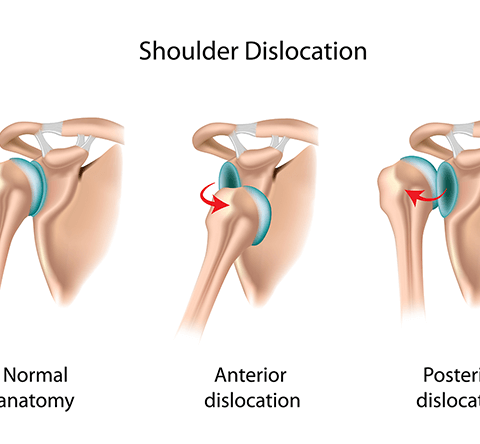A shoulder dislocation occurs when the upper arm bone separates from the scapula’s cup-shaped socket. Since the shoulder is the most flexible joint in the body, dislocations are more common. If you doubt a dislocated shoulder, take immediate medical treatment.
Most people recover full use of their shoulders within a few weeks. On the other hand, a dislocated shoulder may be more prone to repeat dislocations.
Introduction
When something forces the bones in your shoulder joint out of their normal position, a dislocation occurs. The most frequent causes are motor vehicle crashes, sports injuries, and falls. Never attempt to reposition your shoulder by force. If you believe you have a dislocated shoulder, keep your arm still and close to your side and visit the emergency room immediately.
What is a shoulder dislocation?
Shoulder dislocations occur when the bones in your shoulder joint are forced or knocked out of their normal positions. A joint is defined as any place in your body where two bones meet. They are part of your skeletal system. Your shoulder joint is where the round ball at the top of your humerus bone fits into the socket (glenoid) of your shoulder blade (scapula). It can also harm the tissue around your shoulder joint, including your:
- Muscles.
- Nerves.
- Tendons.
- Ligaments.
- Blood vessels.
If your shoulder becomes dislocated or becomes immobile, visit the emergency room. You shouldn’t ever try to reposition your shoulder by yourself.
Shoulder anatomy
Understanding the anatomy of the shoulder helps in understanding how a shoulder can dislocate. Shoulder components include:
- Humeral head: a ball at the top of the humerus
- Glenoid: the space in the shoulder where the humeral head rests.
- Scapula: the shoulder blade
- Labrum: a cartilage rim that lines the interior of the glenoid
- Joint capsule: A collection of ligaments joining the glenoid and humeral head
- Rotator cuff: shoulder joint stabilizing muscles and tendons between the scapula and humerus
Types of shoulder dislocation
Medical professionals classify dislocations based on the degree of joint bone displacement:
- Complete dislocations (luxation): A full dislocation happens when the bones in your joint are isolated and pushed out of place.
- Subluxation: Subluxation is the medical phrase for a partial dislocation. If something pulls on your joint and the bones remaining contact, but not as thoroughly as they usually do, you have a subluxation.
How common are shoulder dislocations?
Shoulders are the most commonly dislocated joint. But they are still a relatively rare injury only around 10 per 100,000 people in the U.S. dislocate a shoulder each year.
Symptoms
The following are the most typical signs of a dislocated shoulder:
- Severe pain.
- Weakness.
- Inability to move your arm.
- Your shoulder is visibly out of place.
- Swelling.
- Bruising or discoloration.
- Muscle spasms.
- Your arm, hand, or fingers may feel numb, tingling, or weak.
What causes shoulder dislocations?
A dislocation can be caused by any force that is strong enough to push your shoulder joint out of position. The most common causes include: The most commonly dislocated joint in the body is the shoulder joint. The shoulder can dislocate forward, backward, or downward due to multiple movements. It may dislocate entirely or in part.
The front of the shoulder sustains the majority of dislocations. The tissue that connects the bones in the shoulder, known as the ligaments, can become torn or stretched, frequently exacerbating the dislocation. It takes a powerful force, such as an impulsive blow to the shoulder, to pull the bones out of place. Excessive twisting of the shoulder joint can pop the ball of the upper arm bone out of the shoulder socket. In a partial dislocation, the upper arm bone is partly in and partially out of the shoulder socket.
Causes of a dislocated shoulder include:
- Sports injuries. A common injury in contact sports like hockey and football is shoulder dislocation. It’s also typical in sports like volleyball, gymnastics, and downhill skiing that could involve falls.
- Trauma is not related to sports. Dislocation can result from a forceful blow to the shoulder sustained in a car crash.
- Falls. Landing awkwardly after a drop, such as from a ladder or tripping on a loose carpet, can dislocate a shoulder.
Dislocated shoulder risk factors
Shoulder dislocations can happen to anyone, but certain individuals are more susceptible than others, such as:
- Athletes who play contact sports.
- Males and people are assigned male at birth (AMAB).
- People between 20 and 30 years old.
- Anyone who has previously dislocated their shoulder.
Shoulder dislocations are more than twice as common in men and AMAB individuals as in women and AFAB individuals, who were assigned female at birth.
What are the complications of a dislocated shoulder?
The following are the most frequent complications of shoulder dislocation: harm to the surrounding tissues and bones:
- Bone fractures.
- Ligament and tendon sprains.
- Nerve injury.
- Impaired blood vessels.
- Muscle strains.
A Hill-Sachs lesion occurs in certain shoulder dislocators. Similar to a sound in the ball of your upper humerus is a Hill-Sachs lesion. The ball at the top of your humerus may sustain damage if your shoulder dislocates and it presses against the upper part of its socket in your scapula.
Diagnosis and Tests
The doctor will perform a physical examination to diagnose a dislocated shoulder. They’ll examine the rest of your arm and your shoulder. Inform your healthcare provider of any symptoms you may be having and your activities just before the shoulder injury.
To diagnose a dislocated shoulder, what tests will be performed?
Your physician might require some of the following imaging tests to diagnose injury inside your body after a dislocation:
- X-rays.
- Magnetic resonance imaging (MRI).
- A computed tomography (CT) scan.
- Ultrasound.
Management and Treatment
Go to the hospital immediately if you think your shoulder might be dislocated. The most important treatment for a dislocated shoulder is getting your arm back into a normal position. This is a technique called a closed reduction or manipulation.
During this conservative method, your provider will physically push and pull your body on the outside to set (align) your shoulder. They might give you a local anesthetic to numb the area near your shoulder or sedatives to relax your entire body. Never attempt to realign your joint on your own.
Additionally, avoid allowing anyone other than a qualified healthcare provider to move or handle your injured shoulder. Avoid forcing yourself to use your shoulder and instead try to hold it as still as possible. Attempting to realign a dislocated shoulder on your own may exacerbate the injury and cause damage to the surrounding tissue.
Following your physician’s advice about your joint, you may need additional therapies, such as:
- Immobilization: You’ll need to keep your injured shoulder stable following your closed reduction by donning a splint or sling. We refer to this as immobilization. It will heal and become less stressed as a result of this. Your doctor may advise you to apply ice to your injured shoulder several times a day. Light exercise may be necessary to prevent your shoulder from freezing or tightening. Find out from your doctor how long the splint or sling will need to be worn, as well as how frequently you should exercise your shoulder. For a few weeks, the majority of people require shoulder immobilization.
- Medication: Your physician will prescribe you medicine that reduces pain and inflammation. Don’t take over-the-counter (OTC) pain relievers for more than ten days in a row without talking to your physician.
- Rest: Any physical activity that strains or uses your shoulder must be avoided. Find out from the doctor what you should not do while you’re healing.
- Physical therapy: You’ll need to begin physical therapy to help your shoulder regain its strength and range of motion as it heals. You most likely won’t do any vigorous motion exercises at first to ease your stiffness. Stretches are necessary to release tension in your shoulder and ensure that it is not too tight once the healing of your shoulder ligaments, or shoulder capsule, has begun.
- You may eventually be asked to add exercises to strengthen the muscles in your shoulders by your physical therapist or healthcare provider. This will lessen the possibility of further dislocations for you. After a shoulder dislocation, physical therapy is typically required for several months.
How can Physiotherapy help?
The healing process can start as soon as the shoulder is back in its natural alignment. For a complete recovery, physiotherapy will assist with:
- Regain movement of the shoulders
- Strengthen the shoulder muscles
- Regain shoulder control
Reducing shoulder soreness can be achieved by applying an ice pack wrapped in a damp towel to the shoulder for ten to fifteen minutes. For pain relief, some patients prefer moist heat.
What is the physiotherapy management for shoulder dislocation?
1. Modalities
Pain relief and relaxation are improved with the use of heat and cold therapy. Ice should always be applied following physical activity or any other activity that causes discomfort. Another option for pain relief is pulsed electrical stimulation. By increasing blood circulation, electric stimulation can speed up the healing process and lessen pain and swelling.
2. Exercise
The muscles surrounding the shoulder joint get stronger with exercise. It takes strong muscles to keep the shoulder joint stable. To prevent repeated shoulder dislocations, it is essential to strengthen and rehabilitate the shoulder muscles. Exercises prescribed by a physiotherapist will reduce shoulder pain and improve shoulder function. It’s common to experience some soreness, aching, or stretching after working out.
Range of Motion (ROM) exercise
Pendulum exercises
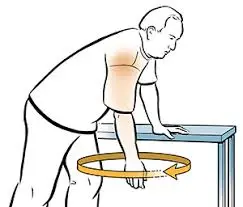
Bend slightly forward and stand with your healthy hand holding a steady surface (the back of a chair, the wall, or a sturdy table). Continuously move the affected side forward and backward. You can also make the same motions with your hands in and out. Ten to twenty repetitions per session.
Shoulder flexion and extension
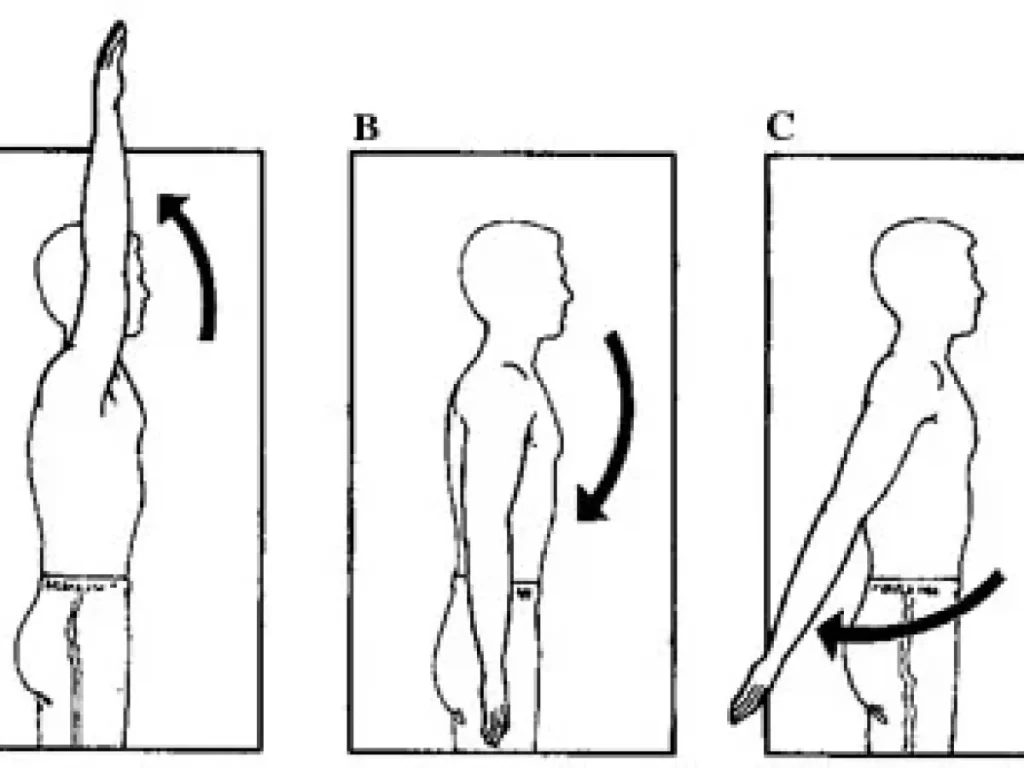
This exercise involves practicing flexion. To begin, hold your arms straight with your palms against your sides. Then, raise your arms in front of your body and point your hands at something in front of you.
Shoulder flexion range of motion is normally 180 degrees. To do this, raise your arms to the highest point that allows you to hold them above your head, starting with your palms against the side of your body.
Extension is a movement that widens the angle at which the joint connects the two components. You are practicing extension if you reach your hands behind you and consider putting something in your back pocket.
A typical range of motion for shoulder extension is between 45 and 60 degrees, Begin by placing your palms adjacent to your body and gradually increase the height at which you can raise your arm behind your back.
Shoulder abduction and adduction
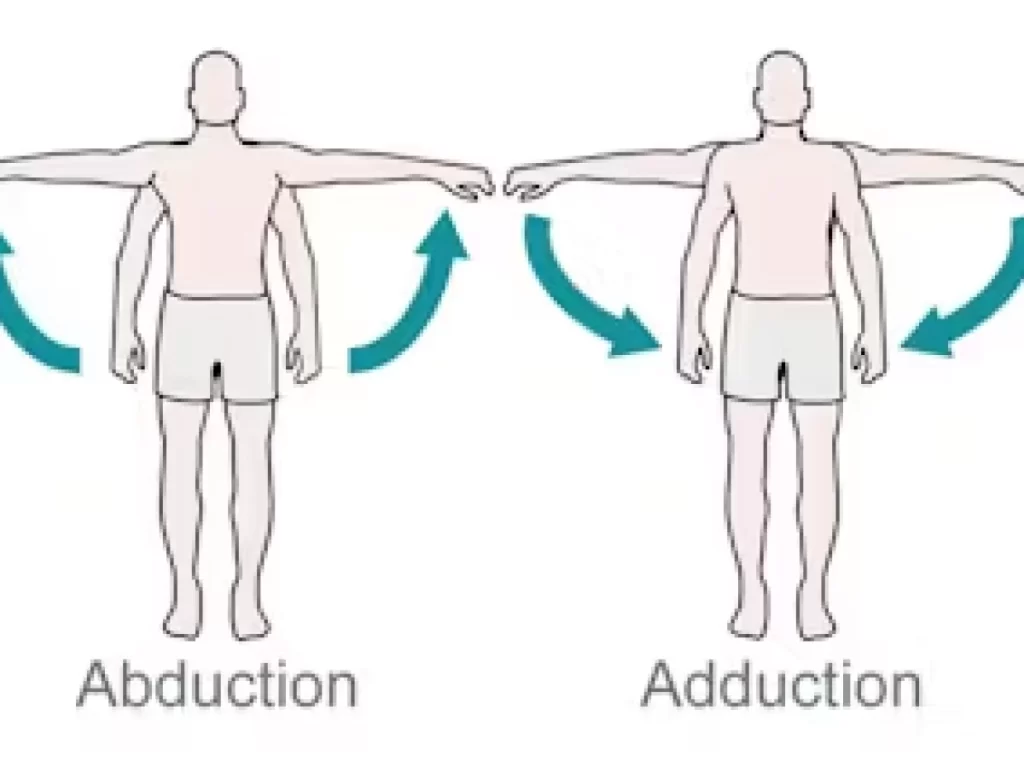
The movement of the arms away from the body’s midline is known as abduction. An abduction of the shoulder occurs when you raise your arm away from your sides.
Starting with your palms at your sides, a healthy shoulder’s normal range for abduction is about 150 degrees. This aligns your arms straight and places your hands above your head.
Reaching your arms towards your midsection is known as shoulder adduction. Hugging oneself causes your shoulders to adduct.
Shoulder adduction ranges normally from 30 to 50 degrees, depending on body composition and flexibility. It might be challenging to move your arms inward if you have very muscular biceps or chest.
shoulder internal and external rotation
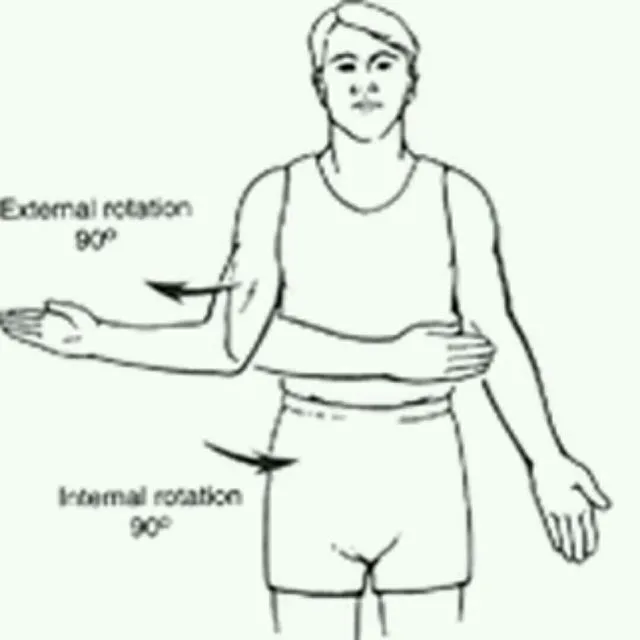
Bend your elbows 90 degrees so that your hands are pointing in front of you while keeping your arms at your sides. Turn your palms towards your body. Move your forearms towards your body while maintaining your elbows pressed against it.
Consider your arms as the cabinet doors, your body as a cabinet, and yourself closing the doors. This is known as medial rotation or internal rotation, and a healthy shoulder should be able to move in the range of 70 to 90 degrees.
Bend your elbows 90 degrees while keeping your arms at your sides and your palms facing your body. Swing your forearms away from your body while maintaining your elbows pressed against it. This is called lateral rotation, or external rotation. A healthy shoulder can move in this manner for ninety degrees at a time.
Stretching exercises for shoulder dislocation
Crossover arm stretch
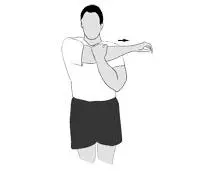
Raise your right arm to your chest slowly and gently. Raise your right arm by the shoulder and hold it with your left hand. Give your stretches a full thirty seconds. For the next thirty seconds, maintain a relaxed right shoulder. Repeat the procedure three more times.
Triceps stretch
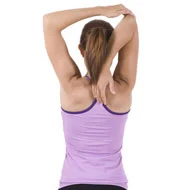
The left hand should be placed on the right shoulder. Place your right hand on your elbow on the left. Raise your left elbow gradually until you sense a slight pull. holding thirty seconds stretching. Once the stretch has been released, take a 30-second break. It is advised to repeat this 2 or 3 more times.
Chest stretch
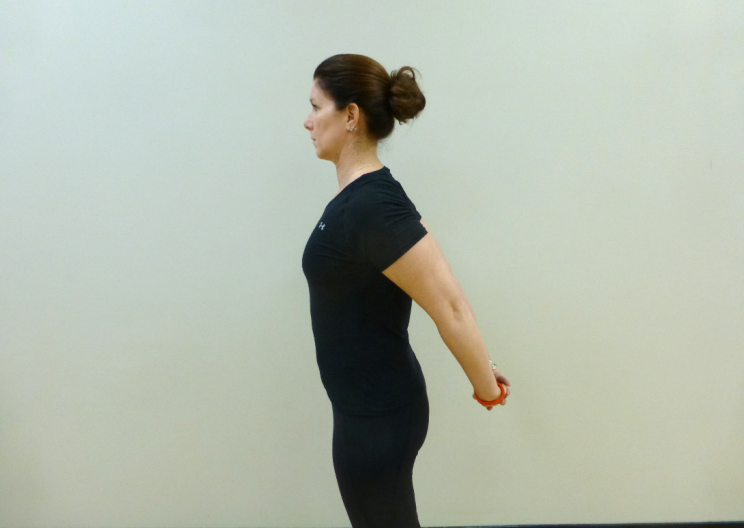
Gently hold your hands behind your back, making sure your palms face you. Maintain your hands together tightly and raise them gradually until you experience a stretch. For 10 to 30 seconds, maintain this. Slowly Lower your hands a little to reduce your grip force. You can stand motionless for up to thirty seconds. It is advised to repeat this one to 3 more times.
Towel exercises
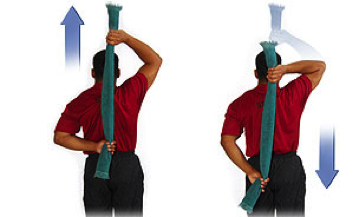
Hold both ends of a bath towel with your hands behind your upper back. The injured hand should be placed with the additional arm and the towel should be positioned vertically. Complete ten rounds of this for ten seconds each.
Strengthening exercises for shoulder dislocation
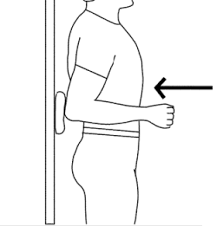
Isometric extension
To start this exercise you have to Stand with your hands by your sides against a wall. After that, rest for five seconds while holding straight wrists and elbows and pushing your palms against the wall. Next, slowly try to extend the push’s duration. complete ten repetitions of this exercise.
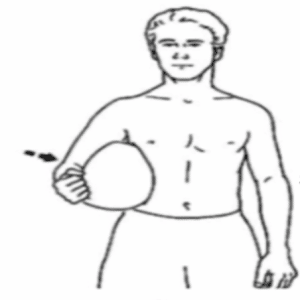
Isometric adduction
Put a small pillow between the affected arm and body. contract it towards the body with your arms and hold the position for ten seconds. You may improve the pillow size once you have practiced on a smaller one.
Which movement you should avoid?
- Strenuous workouts or any exercise that induces pain.
- Exercises such as pull-ups, rows, and raises put your body weight entirely on your shoulder.
- Things that need you to extend your arms behind your back.
- Lifting heavy objects.
- overhead movement should be avoided.
Other interventions for a dislocated shoulder:
This may include further investigations such as ultrasound, CT scan or MRI, pharmaceutical intervention, and corticosteroid injection. Occasionally, patients may require surgery to repair the torn connective tissue or to correct other abnormalities associated with the dislocated shoulder (such as fractures).
Dislocated shoulder surgery
The majority of people who dislocate their shoulders don’t require surgery. Surgery can be necessary if:
- Your body sustained additional harm as a result of the injury that dislocated your shoulder.
- A closed reduction does not work or is not possible. In this case, you’ll require surgery to reset your shoulder joint.
- You have dislocated the same shoulder in the past. You might require surgery to correct or tighten the ligaments that keep your arm connected to your shoulder blade.
Restoring the shoulder’s functionality after it was dislocated requires shoulder dislocation surgery. Fixing other bone fractures that may have happened during the injury is one way to do this, as well as repairing torn ligaments and tendons.
Our orthopedic surgeons and specialists have extensive training in carrying out intricate surgical procedures for shoulder injuries, such as ligament and tendon transfers or reconstruction. This specialized surgical procedure, which helps to restore function and shoulder strength and reduce shoulder pain, is performed by our orthopedic surgeons in very high numbers.
Surgeries performed for shoulder dislocation are:
Advanced Arthroscopic Techniques
Soft tissue injuries and fractures resulting from dislocation of the shoulder are frequently repaired by orthopedic surgeons using minimally invasive arthroscopic procedures. An extremely thin tube known as an arthroscope, which has a tiny light and camera at the end, will be inserted by your surgeon through a tiny incision made in the area around your shoulder.
Surgeons can now see the structures inside the shoulder joint and its surroundings, enabling them to reconstruct and repair ligaments, tendons, and other broken bones. Techniques for arthroscopic surgery enable reduced pain and faster recovery periods.
Ligament and Tendon Reconstruction and Repair
A dislocated shoulder can often be caused by torn tendons and ligaments. Reconstruction of the ligaments and tendons might be required to undo the damage. Orthopedic surgeons perform tendon and ligament reconstruction and/or transfer using sophisticated arthroscopic techniques to restore function and lessen shoulder instability. Future shoulder dislocations are less likely when the tendons and ligaments in the shoulder are strengthened and repaired.
Bone Transfer and Grafting
After a shoulder dislocation, the glenoid (shoulder socket) or humeral head (shoulder ball) bones can suffer damage. It might be necessary to move a fragment of bone to the glenoid or humeral head from another part of the shoulder or body to stabilize the shoulder and prevent further dislocation.
This can be done arthroscopically or through a shoulder incision, and it’s frequently done together with tendon and ligament reconstruction. orthopedic surgeons will talk with you about the best course of action to restore function and lessen shoulder instability because they are skilled in these surgical procedures.
Shoulder Dislocation Surgery Recovery
Your arm will be in a sling for four to six weeks while you heal following shoulder dislocation surgery. Your pain management plan and, when you’re ready, physical rehabilitation to regain your strength and mobility, will be started immediately by your doctor.
After dislocating your shoulder, recovery typically takes several months. After your joint heals, physical therapy will require you to keep your shoulder immobilized for several weeks or months. Find out how long you must wait from your doctor before starting up again. You run a higher risk of reinjuring your shoulder, possibly dislocating it again, if you resume exercising or playing sports before it has completely healed.
Prevention
You can’t always prevent a dislocated shoulder. Trauma and accidents are the usual causes.
During sports or other physical activities:
- Wear the right protective equipment.
- If you have pain during physical activity then avoid it or wear a brace during exercise.
- After a heavy workout, give your body time to rest and heal.
- Before doing physical activity or sports, warm up and stretch.
- Cool down and stretch after physical activity.
- Make sure everything in your house and office is clear of obstructions that could trip you or other people.
- To reach objects, always use the appropriate tools or equipment at home.
- If you have trouble walking or are at a higher risk of falling, use a cane or walker.
Prognosis
Most patients who suffer a dislocated shoulder fully recover. After your shoulder recovers, you should be able to continue most sports, not all your workouts and sports. If you have previously dislocated your shoulder, your chances of dislocation again are much higher.
More than 90% of athletes under the age of 25 who dislocate their shoulder while participating in a contact sport go on to re-injure the same shoulder, according to some studies.
Consult your surgeon or healthcare provider before beginning any new physical activity, especially contact sports. They’ll assist you in knowing what to plan for and how to avoid the same problems in the future.
When should I go to the hospital?
Go to the hospital if you have experienced trauma.
If you feel your shoulder is dislocated:
- Do not move your arm. Hold it close to your body.
- Do not try to obstruct your shoulder back into place and don’t let anyone other than a healthcare provider try to. If non-professionals try to put your shoulder back into place then they can harm blood vessels, muscles, ligaments, and nerves.
Your blood vessels, muscles, ligaments, and nerves could all be harmed when a person else not a professional tries to reposition your shoulder. To reduce discomfort and swelling, apply an ice pack to the affected area. prepare for pain and other symptoms to go away with over-the-counter NSAIDs. Take only the suggested drugs.
Can a dislocated shoulder fix itself?
A dislocated shoulder won’t recover on its own, and it won’t recover properly unless a healthcare provider diagnoses and treats it. Go to the hospital immediately if you have any symptoms of a dislocation after a fall, accident, or sports injury.
Note
When the ball-shaped head of your upper arm bone is forced out of its socket in your shoulder blade, you get a dislocated shoulder. Dislocated shoulders are typically the result of falls, sports-related injuries, and other traumas.
The most common joint to become dislocated is the shoulder. Never attempt to realign your shoulder on your own. It should only be moved or touched by a doctor. If you can’t move or use your arm and believe you have a dislocated shoulder, get to the emergency room immediately.
FAQ
Which are the three types of shoulder dislocation?
Anterior (forward). In front of the glenoid socket, the head of the arm bone (humerus) rotates forward.
Posterior (behind). Above and behind the socket, the head of the arm bone is displaced.
Inferior (bottom).
How can I correct my dislocated shoulder?
The shoulder should pop back into place if you relax, reach your arm over your head, touch the base of your neck with your hand, and reach for the opposing shoulder. As soon as possible after reducing your shoulder, get follow-up medical care.
Does a dislocated shoulder recover on its own?
If a dislocated shoulder is not diagnosed and treated by a medical professional, it will not heal properly. If you experience any dislocation symptoms following a fall, sports injury, or accident, visit the emergency room.
Which five factors cause dislocation of the shoulder?
Five common causes can result in a dislocated shoulder: sports injuries, falls, impact injuries, repetitive stress injuries (RSIs), and loose ligaments. Sports and athletic activities are the most common cause of shoulder dislocations, especially when the shoulder is repeatedly and forcefully used.
After a dislocation of the shoulder, what should I avoid?
Avoid doing the same thing that dislocated your shoulder. Aim to stay clear of uncomfortable motions. Till the shoulder feels better, avoid doing any heavy lifting or overhead activities.
What shoulder surgery is the most painful?
The most painful shoulder surgery is rotator cuff repair. In the early postoperative days following surgery, you may feel pain. Your shoulder will become stiff from lack of movement, which will make your pain worse.
After a shoulder dislocation, when can you begin physical therapy?
You will be referred for physical therapy after your shoulder heals for a period of two to four weeks. Your physical therapist will teach you shoulder-stretching exercises. By doing this, you can make sure that your shoulder mobility is perfect.
References
- Professional, C. C. M. (n.d.-e). Dislocated shoulder. Cleveland Clinic. https://my.clevelandclinic.org/health/diseases/17746-dislocated-shoulder
- Dislocated shoulder – Symptoms and causes – Mayo Clinic. (2022, August 23). Mayo Clinic. https://www.mayoclinic.org/diseases-conditions/dislocated-shoulder/symptoms-causes/syc-20371715#:~:text=A%20dislocated%20shoulder%20is%20an,it%20more%20likely%20to%20dislocate
- Dislocated shoulder – Diagnosis and treatment – Mayo Clinic. (2022, August 23). https://www.mayoclinic.org/diseases-conditions/dislocated-shoulder/diagnosis-treatment/drc-20371720

